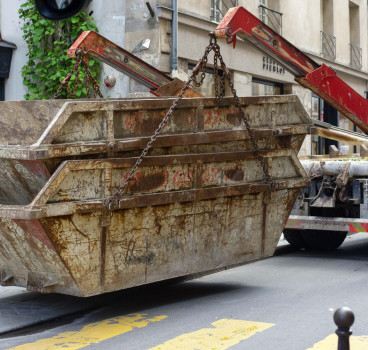Unveiling the world’s five biggest cranes
They pierce the sky, steel monsters defying gravity with their Herculean strength. These are the world's biggest cranes, marvels of engineering capable of lifting objects heavier than blue whales and taller than the Statue of Liberty. Today, we embark on a journey to meet these industrial leviathans, exploring what they do, how they were forged, and why they're crucial cogs in the machinery of modern construction.
SGC-250 (Big Carl - pictured)
Coming in at number one and hailing from the UK, this monster crane stands 250 metres tall and boasts a staggering lifting capacity of 5,000 tonnes. Built by Sarens, Big Carl's primary purpose is assembling nuclear power plants, its colossal arms gently manoeuvring massive reactor components into place.
The Titan of Lifting
- Name: SGC-250, nicknamed "Big Carl"
- Origin: UK, built by Sarens
- Height: 250 metres, taller than the Statue of Liberty (93m) and Big Ben (96m)!
- Lifting Capacity: A staggering 5,000 tonnes, equivalent to 7 jumbo jets or 10 blue whales!
- Primary Purpose: Assembling nuclear power plants, delicately handling massive reactor components.
Beyond the Numbers
- Big Carl is a marvel of design and technology. Its modular construction allows for transportation and assembly on-site. Its intricate counterweight system balances its immense lifting power.
- This giant operates with incredible precision, manoeuvring heavy loads with millimetre accuracy. Advanced computer systems and laser technology ensure safety and stability.
- Big Carl facilitates the construction of vital infrastructure, generating jobs and contributing to energy security.
- Nuclear power plants, while controversial, can be a low-carbon alternative to fossil fuels. Big Carl plays a role in enabling cleaner energy production.
Big Carl is more than just a machine; it's a symbol of human ingenuity and ambition. It represents our ability to tackle colossal challenges and push the boundaries of what's possible. Its size and power inspire awe, while its role in assembling nuclear power plants sparks debate about energy and sustainability.
Liebherr LR 13000
At number two, this German bruiser weighs in at 1,200 tonnes and can lift up to 3,000 tonnes. Its modular design allows for flexible configurations, making it a go-to for wind turbine iAh, the Liebherr LR 13000, another titan of the lifting world! This German powerhouse deserves a closer look:
Meet the LR 13000:
- Nationality: German, built by Liebherr, a renowned engineering company.
- Weight: A hefty 1,200 tonnes, equivalent to 14 blue whales!
- Lifting Capacity: Up to 3,000 tonnes, enough to lift 3 jumbo jets or 6 blue whales simultaneously!
- Modular Design: Its secret weapon! The LR 13000 can be configured in various ways, adapting to different job requirements. This makes it incredibly versatile.
- Key Applications: Wind turbine installations and offshore platform construction are its forte. Its ability to handle massive components on land and at sea makes it invaluable in these sectors.
Beyond the Specs:
- The LR 13000 is a technological marvel. Its powerful winch system, innovative boom design, and sophisticated control systems ensure precision and stability even when lifting colossal weights.
- Its modularity can reduce transportation costs and emissions, making it a more sustainable option for large-scale projects.
- The LR 13000 enables the construction of renewable energy infrastructure like wind farms, contributing to cleaner energy production and job creation.
Terex AC 780-2:
At number 3, this American crane is a master of versatility, offering both crawler and wheeled configurations. With a max lift capacity of 3,200 tonnes, it tackles heavy lifting projects in diverse settings, from bridge construction to oil refinery upgrades.
The Master of Versatility:
- Nationality: American, built by Terex Cranes.
- Lifting Capacity: An impressive 3,200 tonnes, capable of hoisting the weight of over 400 elephants!
- Dual Configurations: Uniquely offers both crawler and wheeled configurations for ultimate adaptability.
- Crawler mode for stability on rough terrain and heavy lifting tasks.
- Wheeled mode for faster transport and manoeuvring on paved surfaces.
- Applications: A true all-rounder, tackling diverse projects in various industries:
- Bridge construction
- Oil refinery upgrades
- Power plant construction
- Industrial plant maintenance
- Petrochemical facility construction
- Shipbuilding
Key Features:
- Driven by a 6-cylinder, turbocharged diesel engine with 354 horsepower.
- Boom Length: Up to 162 metres, extending its reach to incredible heights.
- Counterweight System: Employs a massive counterweight system for balance and stability during heavy lifts.
- Advanced Control Systems: Operates with precision and safety through sophisticated control systems and sensors.
- Transportability: Despite its size, can be disassembled and transported to various job sites using trucks and trailers.
Beyond the Specs:
- Engineered for Efficiency: The AC 780-2 is designed for optimal fuel consumption and reduced emissions, making it a more environmentally conscious choice.
- Economic Impact: Facilitates the construction and maintenance of critical infrastructure, contributing to economic growth and job creation.
- Reliable Performer: Known for its durability, reliability, and ease of operation, making it a favourite among crane operators worldwide.
Mammoet SLC600
In at number 4 this Dutch engineering shines in this 1,200-tonne crane, designed specifically for offshore wind farm installations. Its innovative "jack-up" system elevates the crane above the water, providing a stable platform for intricate turbine assembly tasks.
The Offshore Wind Champion
- Nationality: Dutch, built by Mammoet, a leading company in heavy lifting and transportation.
- Weight: 1,200 tonnes, a formidable force on the high seas!
- Lifting Capacity: Up to 600 tonnes, enough to lift several wind turbine nacelles (the housing that contains the generator) or a medium-sized passenger airplane.
- Key Feature: The innovative "jack-up" system. This system uses hydraulic legs to elevate the crane platform above the water, creating a stable base for delicate wind turbine assembly tasks. This avoids the need for a traditional vessel, making the SLC600 more efficient and cost-effective.
- Applications: Primarily used for offshore wind farm installations, including:
- Lifting and installing wind turbine nacelles.
- Hoisting and positioning blades onto wind turbines.
- Performing maintenance and repair work on offshore structures.
- Advantages:
- Stability: The jack-up system provides a stable platform even in rough conditions, crucial for precise wind turbine assembly.
- Versatility: Can be used for various tasks beyond nacelle and blade installation.
- Efficiency: Avoids reliance on traditional vessels, saving time and money.
- Sustainability: Contributes to the growth of clean energy production through wind power.
Beyond the Tech Specs
- Mammoet's Expertise: The SLC600 is a testament to Mammoet's years of experience in heavy lifting and offshore operations. Their dedication to innovation and safety shines through in this design.
- Challenges of Offshore Wind: Offshore wind farms pose unique challenges, including harsh weather conditions, complex logistics, and the need for specialised equipment. The SLC600 addresses these challenges head-on, making wind farm construction more feasible and cost-effective.
- Future of Offshore Wind: With the growing demand for renewable energy, offshore wind is expected to play a significant role in the future. The SLC600 and similar innovative technologies are paving the way for a sustainable and energy-independent future.
Demag CC 8800-2
In at number 5, this is where German precision meets brute force in this crane, capable of lifting 2,200 tonnes. Its compact design and high manoeuvrability make it ideal for congested job sites, tackling heavy industrial tasks like crane tandem lifts and nuclear reactor maintenance.
Demag CC 8800-2: German Muscle for Tight Spaces
- Nationality: German, built by Demag, a renowned crane manufacturer now part of Tadano.
- Lifting Capacity: A hefty 2,200 tonnes, enough to hoist 3 jumbo jets or 5 blue whales!
Strengths:
- Compact design: Unlike many other large cranes, the CC 8800-2 is surprisingly compact, making it ideal for congested job sites where space is limited.
- High manoeuvrability: Its innovative design and powerful hydraulics allow for precise and agile movements, even in tight spaces.
- Versatility: Can handle a wide range of heavy industrial tasks, including:
- Crane tandem lifts: Combining its strength with other cranes for even heavier lifting needs.
- Nuclear reactor maintenance: Precisely manoeuvring and lifting heavy reactor components.
- Bridge construction: Lifting and positioning large bridge sections.
- Industrial plant maintenance: Handling heavy machinery and equipment.
Technology:
- Advanced control system: Ensures smooth and safe operation even in challenging conditions.
- Modular design: Allows for configuration adjustments to suit specific job requirements.
- Powerful engine: Provides the necessary muscle for lifting massive loads.
- Impact:
- Enables complex construction projects: Its compact size and manoeuvrability make it invaluable for projects with limited space.
- Improves efficiency and safety: Accurate movements and advanced technology reduce risks and optimize work processes.
- Supports critical industries: Plays a crucial role in maintaining and repairing nuclear power plants and other vital infrastructure.
Why Do We Need These Mega-Cranes?
These gargantuan machines are the backbone of modern infrastructure development. They enable us to construct towering skyscrapers, bridge expansive waterways, and harness the power of wind and tides. They're testaments to human ingenuity, pushing the boundaries of engineering to achieve the seemingly impossible.
So next time you gaze upon a cityscape dotted with cranes, remember the titans lurking beneath their metallic skins. These are the world's biggest cranes, silently wielding their immense power to shape our world, one colossal lift at a time.
Additional Articles

What construction can learn from Ant colonies about logistics and site movement
If you want to witness flawless logistics, responsive movement and coordinated planning in action, you do not need to observe a hyper-automated warehouse or a cutting-edge construction site - you...
Read moreWhy everyone has a favourite skip and what it says about you
In construction, there are two universal truths – tea, of course, is essential and believe it or not, everyone - whether they are prepared to admit it - has a favourite skip. It may sound strange,...
Read more

The cultural significance of the bacon roll in UK construction
Walk onto any construction site in the UK at 7:30am and you’ll quickly discover that the most important piece of equipment isn’t a digger, a drill or a laser level. It’s a humble, foil-wrapped,...
Read more